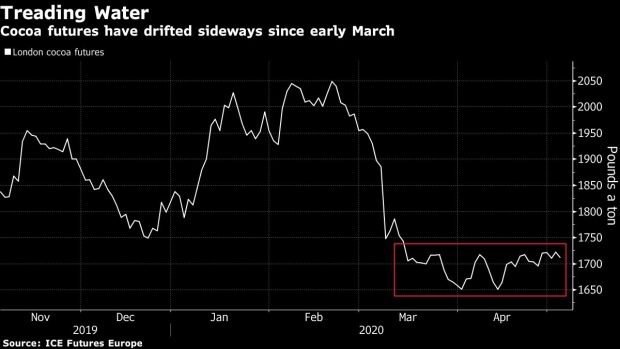May 6, 2020
Chocolate Market Weakens With Fewer Treats in Lockdown
, Bloomberg News

(Bloomberg) -- Cocoa grindings have beat expectations this year and prices have started holding up, but don’t be fooled: there’s a grim picture emerging for chocolate demand.
Better-than-anticipated European and Asian grindings -- where beans are turned into products used in chocolate bars -- recently suggested that demand may have proved fairly resilient to the coronavirus crisis. But analysts and traders say that was fueled more by processors ramping up output ahead of potential supply-chain disruptions, rather than real consumption.
There are already signs that demand is falling as lockdowns shutter some retail outlets and prompt fewer impulse purchases. Chocolate companies like Nestle SA and Mondelez International Inc. have reported easing sales or warned about confectionery demand, and there are worries that rising unemployment and lower incomes will curb spending on treats.
“These sales figures and other anecdotal evidence are suggesting a disconnect between grind and consumption,” said Jonathan Parkman, co-head of agriculture at Marex Spectron Group in London. “The evidence is beginning to stack up that the increase in grindings may have had more to do with filling up the supply chain than any increase in sales.”
It’s likely that lockdowns will reduce chocolate gifting, impulse buying and purchases of premium products, he said.
Even though first-quarter grindings largely fared better than expected, Nestle and Hershey Co. saw declines in confectionery sales volumes during the period. While supermarket and online sales of chocolate snacks in Europe were fairly steady in April, that’s unlikely to compensate for slumping sales of at least 80% elsewhere at places like fuel stations, specialist stores and vending machines, said Maxime Boucher, an analyst at Bloomberg Intelligence.
In Europe, the biggest chocolate-consuming region, chocolatiers offered steep discounts last month to entice buyers. Companies have so far remained quite tight-lipped about demand prospects, but Lindt & Spruengli AG and Hershey have withdrawn their 2020 outlook. Lindt’s first-half sales will probably drop 14%, Bank Vontobel AG estimates.
Mondelez’s chief executive officer last week warned that sales growth in categories including chocolates and biscuits will slow, while processor Barry Callebaut AG said its gourmet and specialties volumes will be particularly impacted by waning out-of-home consumption.
The fallout from the pandemic will be reflected in second-quarter grindings and earnings from chocolate companies, said Eric Bergman, vice president at JSG Commodities in Norwalk, Connecticut.
“Falling chocolate demand has the potential to turn global grindings growth negative for the current year,” he said. “This significantly narrows the expected deficit and may even put the current year into surplus.”
Olam International Ltd., the third-largest processor, now expects global grindings to fall 1.5% this season, the first drop in four years. Some analysts are calling for bigger declines, and many traders estimate a global cocoa surplus for the current season.
Still, cocoa futures have largely drifted sideways since early March, suggesting that demand worries haven’t increased since then. Olam’s chief trading officer last month said traders should pay more attention to bad weather that’s hit crops in top grower West Africa and that there are supply risks ahead. Global output will be 100,000 tons smaller than forecast late last year after desert winds curbed West African production, he said.
“There is currently some tightness in West Africa with pressure on cocoa port arrivals, and irregular weather patterns increases worries over supply going forward,” said Casper Burgering, an economist at ABN Amro Bank NV in Amsterdam. “These worries will persist and keep prices volatile.”
Still, demand remains the biggest unknown for the market. While some nations in Europe are preparing to reopen economies, it’s unclear how cocoa demand will fare going forward.
“Chocolate demand in western Europe and North America is closely linked to GDP,” said Paul Hutchinson, chief trading officer for Olam Cocoa. If this is U- or V-shaped, we would expect grindings to recover.”
©2020 Bloomberg L.P.





